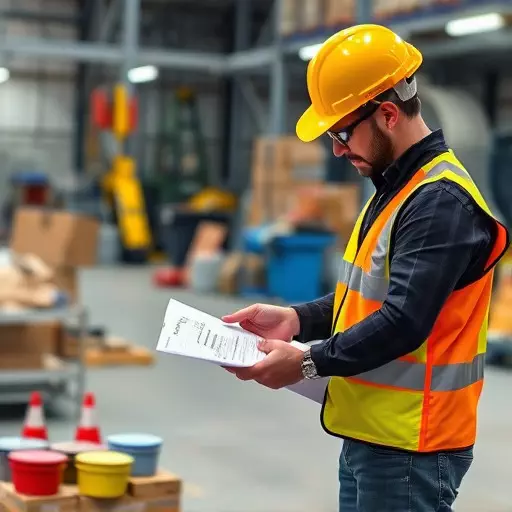Onsite EHS services are vital for workplace safety audits, conducting thorough hazard identification and risk assessment. They meticulously examine physical conditions, equipment, and procedures to uncover potential dangers like chemical exposure, ergonomic risks, and fire hazards. These experts collaborate with management to implement control measures, ensuring compliance with regulations and fostering a culture of continuous improvement. Regular follow-up inspections by onsite EHS services maintain a safe work environment through comprehensive hazard identification, risk assessment, and corrective actions.
Workplace safety audits are essential for identifying potential hazards and mitigating risks. This comprehensive overview explores the critical role of onsite EHS (Environmental, Health, and Safety) services in enhancing these processes. We delve into the steps of hazard identification, where professionals uncover hidden dangers, and risk assessment, quantifying threats and implementing effective mitigation strategies. Post-audit actions are also covered, emphasizing continuous improvement through proactive measures. By integrating these practices, organizations ensure a safer, more productive work environment.
- Understanding Workplace Safety Audits: A Comprehensive Overview
- The Role of Onsite EHS Services in Audit Process
- Hazard Identification: Uncovering Potential Risks in the Workplace
- Conducting Risk Assessments: Quantifying and Mitigating Dangers
- Post-Audit Actions: Ensuring Continuous Improvement
Understanding Workplace Safety Audits: A Comprehensive Overview

Workplace safety audits are a critical component of ensuring a secure and healthy work environment. These comprehensive assessments involve a systematic review of an organization’s operations, focusing on identifying potential hazards and evaluating existing control measures. By conducting regular audits, companies can proactively manage risks and maintain compliance with relevant health and safety regulations.
Onsite EHS (Environmental Health and Safety) services play a pivotal role in facilitating these audits. Professionals from these services possess the expertise to conduct thorough hazard identification and risk assessment processes. They meticulously examine workplace conditions, procedures, and equipment to pinpoint any potential dangers. This includes evaluating chemical exposure, ergonomic risks, fire hazards, and more. Once identified, these professionals collaborate with management to implement effective control measures, ensuring a safer workplace for all employees.
The Role of Onsite EHS Services in Audit Process

Onsite EHS Services play a pivotal role in the workplace safety audit process, providing expert guidance and ensuring comprehensive coverage during assessments. These professionals are equipped to conduct thorough inspections, identify potential hazards, and evaluate existing control measures. By integrating their knowledge with the latest regulatory standards, they facilitate hazard identification and risk assessment – key components of effective workplace safety audits.
Their expertise extends beyond compliance; onsite EHS services foster a culture of continuous improvement. They offer practical recommendations for enhancing safety protocols, implementing better practices, and mitigating risks. This not only bolsters an organization’s commitment to workplace safety but also contributes to fostering a safer, more productive work environment.
Hazard Identification: Uncovering Potential Risks in the Workplace

Workplace safety audits begin with a thorough process known as hazard identification, which involves uncovering potential risks in the workplace. Onsite EHS services employ specialized professionals who meticulously assess every aspect of the work environment to identify hazards that may pose risks to employees’ health and safety. This includes examining physical conditions, procedures, equipment, substances used, and even the layout of the workspace. By systematically identifying these hazards, organizations can initiate effective risk assessment—a critical step in mitigating potential workplace dangers.
Hazard identification goes beyond surface-level observations. It involves analyzing tasks, processes, and typical work activities to predict possible outcomes that could lead to accidents or health issues. Through this comprehensive approach, onsite EHS services ensure that no stone is left unturned in the pursuit of a safe and healthy work environment, forming the foundation for proactive workplace safety measures.
Conducting Risk Assessments: Quantifying and Mitigating Dangers

Workplace safety audits often begin with a thorough risk assessment, which is a crucial step in identifying potential hazards within an organization. This process involves scanning for both obvious and hidden dangers that could pose risks to employees, visitors, or clients. Onsite EHS (Environmental Health and Safety) services professionals are trained to conduct these assessments systematically, examining every aspect of the workplace environment, from physical structures to chemical storage and handling practices.
Quantifying risks is a critical part of the assessment where each identified hazard is evaluated for its likelihood of causing harm and the potential severity of consequences. This enables employers to prioritize dangers and implement effective mitigation strategies. By conducting regular hazard identification and risk assessments as part of workplace safety audits, organizations can ensure they have robust health and safety practices in place, fostering a safer environment for all.
Post-Audit Actions: Ensuring Continuous Improvement

After a comprehensive workplace safety audit, the next crucial step is to translate findings into actionable items. This process involves careful consideration of each identified hazard and risk. Prioritize addressing critical issues first, focusing on those with the most significant potential impact or likelihood of occurrence.
Onsite EHS services play a vital role in facilitating this transition by providing expert guidance on implementing corrective actions. They help organizations conduct thorough risk assessments and develop effective mitigation strategies. Regular follow-up inspections are also essential to monitor progress, ensure continuous improvement, and maintain a safe working environment.


